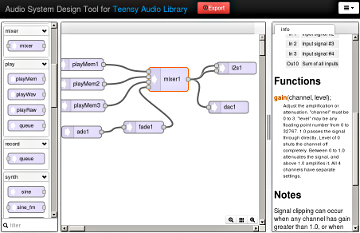@dubbylabby said:
I will ask my brother about it and come with answers :wink:
Meanwhile taking a deeper look into the CDM article and documentation we can find the Teensy Audio Library (full compatible with this project) also based in block patching ala pd/max
https://youtu.be/wqt55OAabVs

https://www.pjrc.com/teensy/gui/index.html
https://github.com/adafruit/Audio/
https://www.pjrc.com/teensy/td_libs_Audio.html
About audiomemory usage:
https://www.pjrc.com/teensy/td_libs_AudioConnection.html
About Interrupts:
https://www.pjrc.com/teensy/td_libs_AudioProcessorUsage.html
How to create new modules:
https://www.pjrc.com/teensy/td_libs_AudioNewObjects.html
Roadmap:
https://www.pjrc.com/teensy/td_libs_AudioRoadmap.html
Let's take in consideration this is the teensy/adafruit Library which is awesome but isn't the one dadamachines is going to develop dedicated to the board (but compatible as I said) so we can expect something similar but on stereoids and hopefully Teensy developer will help in improve all since he is an amazing human kind.
So to put light on this Doppler works with Arduino IDE ergo this and lots of coding out there.
FPGAs have the ability to become hardware from coding them and it could be possible to develop something in this way and later export it as standalone hardware with its own memory (inside the FPGA or attached as module) like GEM works on Max(msp) environment.
This is still young but I see a huge potential and not so complex coding metaphor to get an standalone box someday. It's like the missing piece on the puzzle between pd/Max environments and iOS developing (the other similar piece to this is MobMuPlat) so it's a matter of time that some kind of wrapper will emerge (it could be possible to port LibPd into this hardware and just make it run pd patches but I can imagine the dadamachines proposal gone even further since Zmors modulars is similar approaching)
https://www.youtube.com/watch?v=MyaEPf5h9H0
https://www.youtube.com/watch?v=jRED831GkwU
I need to study the physical side of hardware loopers to understand what components are involved (alongside ADC/DAC, memory and CPU) and maybe patch something into Max as proof of concept (Beap! modules make this easy in comparison to C coding) so maybe the question now is how imagine a GTL box in feature terms going from must to wishlist and find the way to help @[deleted] to port/adapt the coding to make this a value proposition for GTL as platform. This also could help with revenue for him since it's common the low revenues iOS developers get from Apple...
I will dig more into FPGAs themselves and come back as I said.
From CDM article too:
https://ds0.me/oshug.pdf
FPGA structure:
- Modern FPGAs aren’t just LUTs and DFFs!
- Block RAM: dual port SRAM, usually 4-36 kbit
- DSP: multiplier and adders
- High speed IO blocks for DDR memory, HDMI, PCI Express, etc
- Even CPUs! (Zynq ARM cores, Virtex-II Pro PPC)
From https://blog.hackster.io/dadamachines-doppler-development-board-packs-both-a-sam-d51-and-ice40-fpga-f09a62aadd29
On the hardware end, the Doppler features an Arm Cortex-M4F (SAM D51), an FPGA 5000 LUT (1Mb RAM, 6 DSP cores, OSC, PLL), and is both Arduino IDE compatible and breadboard friendly. The board sports a micro USB port, 3.5V to 5.5V VCC, 4 X 4 LED matrix, 2X DAC pins, 10X ADC pins, and all GPIO have 3.3V logic level. It also offers a pair of user buttons, an AREF solder jumper, SWD program pin headers, and uses a UF2 bootloader with firmware uploaded via USB stick mode.
I will back :wink:
Cheers!